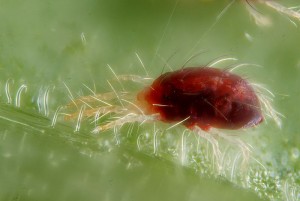 Spider mites are less than one millimeter in size and vary in color. They typically live on the underside of the leaves of plants. The spider mite punctures the plant so it can feed which causes damage to the plant cells. The spider mite has whiplike mouthparts that cause bruising on plant cells. Symptoms include flecking, discoloration, and scorching of the leaves. The injury can lead to leaf loss and even plant death. While causing stress and injury to the plant, they simultaneously increase their population quite quickly. One female can lay up to 20 eggs per day and can live for two to four weeks.
Spider mites are less than one millimeter in size and vary in color. They typically live on the underside of the leaves of plants. The spider mite punctures the plant so it can feed which causes damage to the plant cells. The spider mite has whiplike mouthparts that cause bruising on plant cells. Symptoms include flecking, discoloration, and scorching of the leaves. The injury can lead to leaf loss and even plant death. While causing stress and injury to the plant, they simultaneously increase their population quite quickly. One female can lay up to 20 eggs per day and can live for two to four weeks.
The spider mites can hatch in as little as three days and become sexually mature in as little as five days. The eggs are protected in a silk web that the spider mites spin, which is where the “spider” part of their name comes from.
There are a variety of methods to control spider mites. These include predators, chemicals, and water. One group of small, dark-colored lady bugs known as the “spider mite destroyers” (Stethorus species) are natural predators of spider mites. Chemical control typically involves pesticides that are specifically developed for spider mite control. These are miticides or acaricides. The accelerated reproductive rate of spider mites allows them to adapt quickly and thus resist pesticides. Most of these chemicals are also ineffective on the eggs. Surprisingly, a good forceful blast of water can physically remove and kill many mites. Disrupting the webbing also may delay egg laying, at least until new webbing is produced.
For questions, concerns or comments, feel free to reach out to our team. We can be reached in the office at 602-252-6434, via email at info@xeriscapes.com, or connect with us socially at www.Facebook.com/Xeriscapes and on Twitter @XeriscapesAZ.